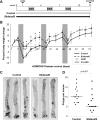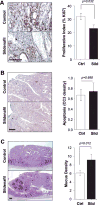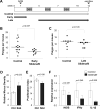Sildenafil Suppresses Inflammation-Driven Colorectal Cancer in Mice
- PMID: 28468928
- PMCID: PMC5530733
- DOI: 10.1158/1940-6207.CAPR-17-0015
Sildenafil Suppresses Inflammation-Driven Colorectal Cancer in Mice
Abstract
Intestinal cyclic guanosine monophosphate (cGMP) signaling regulates epithelial homeostasis and has been implicated in the suppression of colitis and colon cancer. In this study, we investigated the cGMP-elevating ability of the phosphodiesterase-5 (PDE5) inhibitor sildenafil to prevent disease in the azoxymethane/dextran sulfate sodium (AOM/DSS) inflammation-driven colorectal cancer model. Treatment of mice with sildenafil activated cGMP signaling in the colon mucosa and protected against dextran-sulfate sodium (DSS)-induced barrier dysfunction. In mice treated with AOM/DSS, oral administration of sildenafil throughout the disease course reduced polyp multiplicity by 50% compared with untreated controls. Polyps that did form in sildenafil treated mice were less proliferative and more differentiated compared with polyps from untreated mice, but apoptosis was unaffected. Polyps in sildenafil treated mice were also less inflamed; they exhibited reduced myeloid-cell infiltration and reduced expression of iNOS, IFNγ, and IL6 compared with untreated controls. Most of the protection conferred by sildenafil was during the initiation stage of carcinogenesis (38% reduction in multiplicity). Administration of sildenafil during the later promotion stages did not affect multiplicity but had a similar effect on the polyp phenotype, including increased mucus production, and reduced proliferation and inflammation. In summary, the results demonstrate that oral administration of sildenafil suppresses polyp formation and inflammation in mice treated with AOM/DSS. This validation of PDE5 as a target highlights the potential therapeutic value of PDE5 inhibitors for the prevention of colitis-driven colon cancer in humans. Cancer Prev Res; 10(7); 377-88. ©2017 AACRSee related editorial by Piazza, p. 373.
©2017 American Association for Cancer Research.
Figures






Comment in
-
Validation of PDE5 as a Chemoprevention Target.Cancer Prev Res (Phila). 2017 Jul;10(7):373-376. doi: 10.1158/1940-6207.CAPR-17-0136. Epub 2017 Jun 9. Cancer Prev Res (Phila). 2017. PMID: 28600399 Free PMC article. No abstract available.
-
Mutations of the PDE5A Gene Confer a Survival Advantage in Patients with Colon Cancer.Cancer Prev Res (Phila). 2018 Jul;11(7):439-440. doi: 10.1158/1940-6207.CAPR-18-0105. Epub 2018 May 3. Cancer Prev Res (Phila). 2018. PMID: 29724712 No abstract available.
References
-
- Beaugerie L, Itzkowitz SH. Cancers complicating inflammatory bowel disease. N Engl J Med. 2015;372(15):1441–52. - PubMed
-
- Rothwell PM, Fowkes FG, Belch JF, Ogawa H, Warlow CP, Meade TW. Effect of daily aspirin on long-term risk of death due to cancer: analysis of individual patient data from randomised trials. Lancet. 2011;377(9759):31–41. - PubMed
MeSH terms
Substances
Grants and funding
LinkOut - more resources
Full Text Sources
Other Literature Sources
Medical

